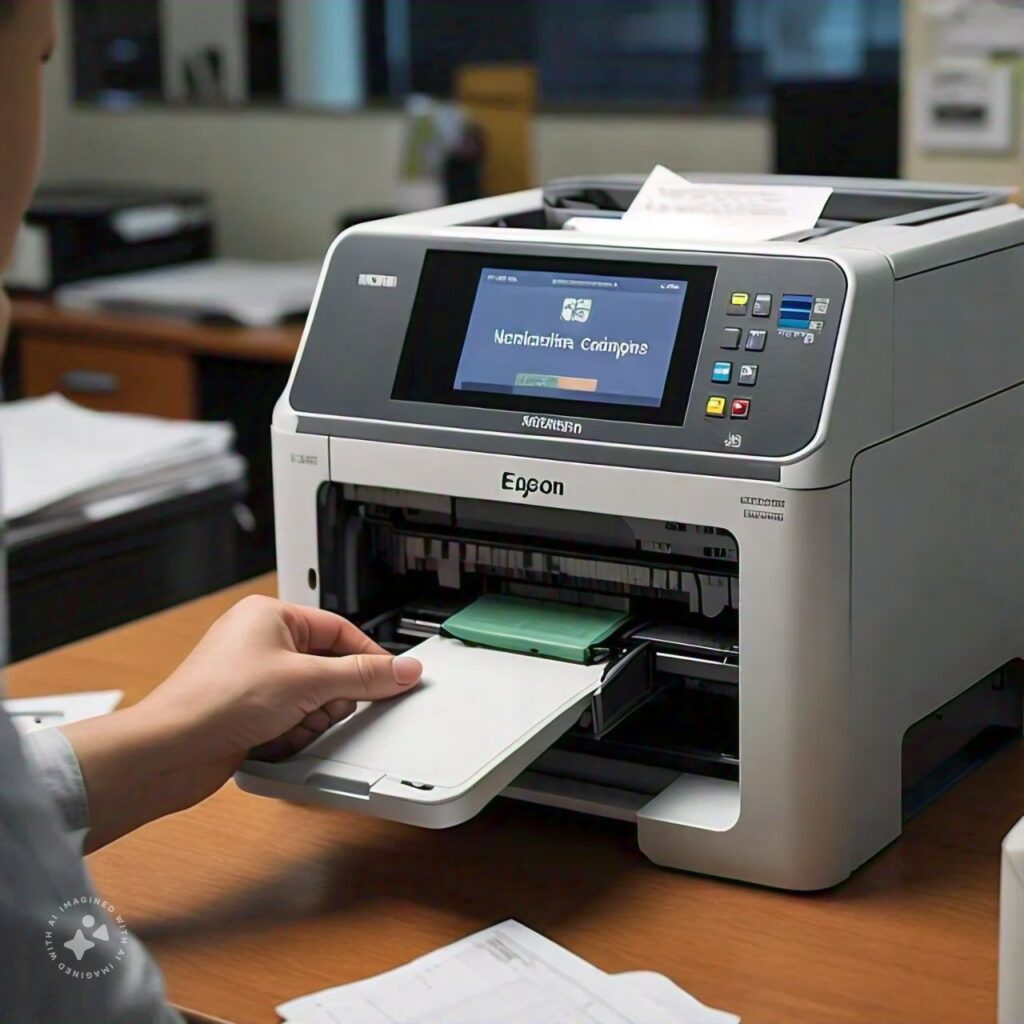How to Use Non-Genuine Ink in Epson Printers
Using non-genuine ink in Epson printers has become a popular choice for many individuals looking to reduce printing costs without sacrificing quality. However, navigating the process of using third-party or compatible ink cartridges in an Epson printer can come with challenges, such as error messages or ink recognition issues.
This comprehensive guide will walk you through the steps to use non-genuine ink in an Epson printer, the pros and cons of doing so, and the best practices to ensure smooth operation and optimal print quality.
What is Non-Genuine Ink?

What is Non-Genuine Ink?
Genuine vs. Non-Genuine Ink
Genuine ink cartridges are those manufactured and sold by the printer’s brand, in this case, Epson. These cartridges are designed specifically for your printer model and come with guarantees regarding print quality, reliability, and longevity. They are, however, typically more expensive than third-party options.
Non-genuine ink or third-party ink cartridges, on the other hand, are produced by companies other than the printer manufacturer. These cartridges are designed to be compatible with a range of printers, including Epson models, but come at a significantly lower cost.
While non-genuine ink can save you money, it’s essential to understand the potential challenges and how to mitigate them to maintain the quality of your prints and the performance of your printer.
Why Use Non-Genuine Ink?
The primary reason many people opt for non-genuine ink is cost savings. Genuine ink cartridges from Epson can be quite expensive, particularly if you print in high volumes. Non-genuine cartridges offer a more affordable alternative without significantly affecting print quality if used properly. Additionally, non-genuine inks are widely available and come in a variety of formulations to suit different printing needs.
How to Install Non-Genuine Ink in an Epson Printer
Step 1: Confirm Compatibility
Before purchasing and installing non-genuine ink cartridges, it’s crucial to verify that they are compatible with your specific Epson printer model. Check the product details and specifications to ensure the cartridge will work with your printer. Most third-party manufacturers will list the printer models their cartridges are compatible with, but it’s always a good idea to double-check with the seller.
- Research: Read online reviews or customer feedback to ensure other users have successfully used the non-genuine ink in your printer model.
Step 2: Remove the Genuine Ink Cartridge
Once you’ve purchased a compatible non-genuine ink cartridge, you can proceed with installation. Start by turning on your printer and opening the ink cartridge access door.
- Locate the ink cartridge: Find the ink cartridge you want to replace. The cartridges are usually marked with the color or identification number.
- Remove the cartridge: Gently press the tab on the cartridge and pull it out of its slot.
Step 3: Install the Non-Genuine Ink Cartridge
Now that you’ve removed the genuine ink cartridge, it’s time to install the non-genuine one.
- Prepare the new cartridge: Take the new non-genuine ink cartridge out of its packaging. Some cartridges have a protective tape or seal over the ink outlet, so make sure to remove this before installing it.
- Insert the new cartridge: Carefully place the new cartridge into the printer’s slot, making sure it clicks into place securely.
- Close the ink access door: After installing the cartridge, close the door to the ink compartment, and your printer should automatically recognize the new cartridge.
Step 4: Deal with Error Messages
In some cases, Epson printers may not immediately recognize non-genuine ink cartridges and will display an error message. The most common error messages include “Cartridge not recognized” or “Non-genuine ink installed.”
Here’s how to handle these errors:
- Bypass the warning: When your printer displays a message that non-genuine ink has been installed, you can usually bypass this by pressing the OK or Resume button. On some printer models, you may need to hold the Stop button for 5-10 seconds to override the warning.
- Disable Epson ink monitoring: Some users report success by disabling the Epson ink monitoring system, which can prevent your printer from rejecting third-party cartridges. This option may be available in your printer settings or software interface.
Step 5: Perform a Test Print
After successfully installing the non-genuine ink and bypassing any error messages, perform a test print to ensure the ink is working correctly and that there are no issues with the print quality.
- Check for streaks or smudges: If the print quality is subpar, try running a printhead cleaning or nozzle check through the printer’s maintenance menu.
- Adjust color settings: Non-genuine ink may not always match the color profile of genuine Epson ink, so you might need to adjust the color settings to ensure accurate prints.
Best Practices for Using Non-Genuine Ink
1. Buy from Reputable Sellers
One of the most important things to consider when using non-genuine ink is purchasing from a reputable seller. Not all third-party ink cartridges are created equal, and buying low-quality ink can lead to poor print quality or even damage your printer. Look for cartridges that have positive reviews and are known for being reliable.
- Check for warranties: Some third-party ink suppliers offer warranties or guarantees that their products won’t damage your printer, which can provide extra peace of mind.
2. Regularly Clean Your Printheads
Using non-genuine ink can sometimes lead to clogs in your printer’s printheads. To prevent this, it’s important to perform regular maintenance, including cleaning the printheads and running nozzle checks. Most Epson printers have built-in maintenance features that can help with this process.
- Avoid long periods of inactivity: If you’re using non-genuine ink, try to avoid leaving your printer inactive for long periods, as this can cause the ink to dry and clog the printheads.
3. Monitor Ink Levels
One potential downside to using non-genuine ink is that your Epson printer may not accurately track ink levels, leading to premature low-ink warnings or print failures. You’ll need to manually monitor your ink levels and replace the cartridges as needed to avoid running out mid-print.
- Print a test page periodically to check if the colors are fading or becoming inconsistent, which can indicate low ink.
4. Accept the Risk of Voiding Your Warranty
Epson, like many other printer manufacturers, states that using non-genuine ink can void your printer’s warranty. If your printer is still under warranty, weigh the cost savings of third-party ink against the risk of not being able to claim repairs under warranty if something goes wrong.
- Keep your printer maintained: Regular maintenance and care can help ensure that using non-genuine ink doesn’t lead to technical issues.
Pros and Cons of Using Non-Genuine Ink in Epson Printers
Pros
- Cost savings: The most obvious advantage of using non-genuine ink is that it’s much cheaper than buying genuine Epson cartridges, making it a popular choice for those who print frequently or in large volumes.
- Wide availability: Non-genuine ink is available from many different manufacturers, giving users a wide range of options to choose from.
Cons
- Potential warranty issues: As mentioned, using non-genuine ink can void your printer’s warranty, which is a significant consideration if your printer is new or still under coverage.
- Ink quality variance: Not all third-party inks deliver the same level of print quality as genuine Epson ink, and you may experience color discrepancies or lower resolution prints.
- Printer errors: Non-genuine cartridges may not always be recognized by your Epson printer, requiring you to troubleshoot and bypass error messages.
Conclusion: Is Non-Genuine Ink Right for Your Epson Printer?
Using non-genuine ink in an Epson printer can be a cost-effective solution for those who want to save money on printing expenses. While there are some risks involved, such as the potential voiding of your warranty and possible print quality issues, many users find that the benefits of cheaper ink outweigh these concerns.
By following the steps outlined in this guide, including ensuring compatibility, bypassing error messages, and maintaining your printer regularly, you can enjoy the savings of non-genuine ink while still producing high-quality prints. Just remember to source your ink from reputable suppliers and perform routine printer maintenance to avoid any long-term issues.




Post Comment